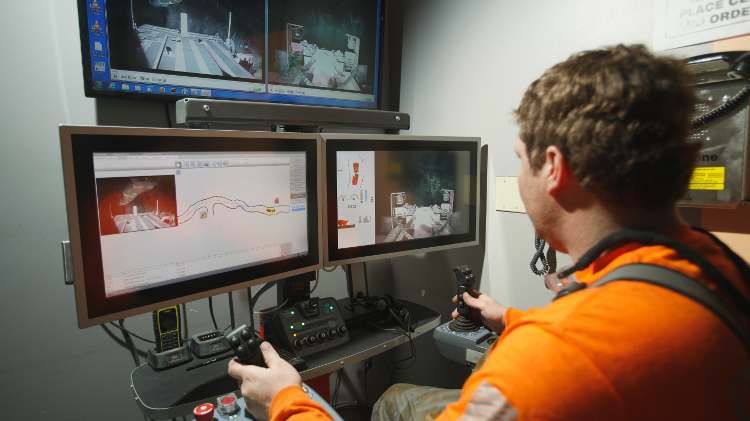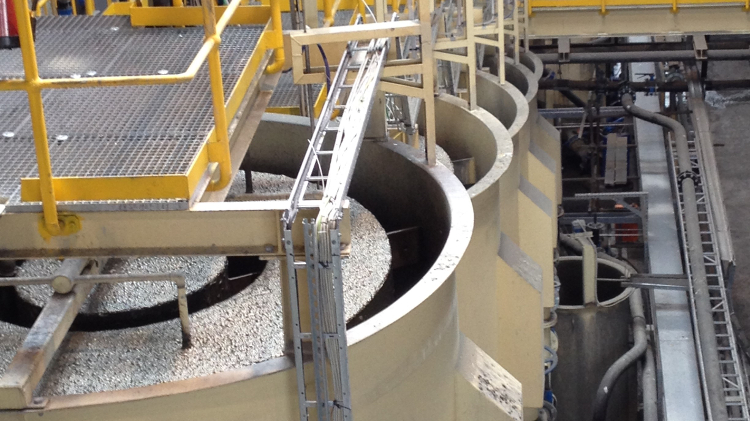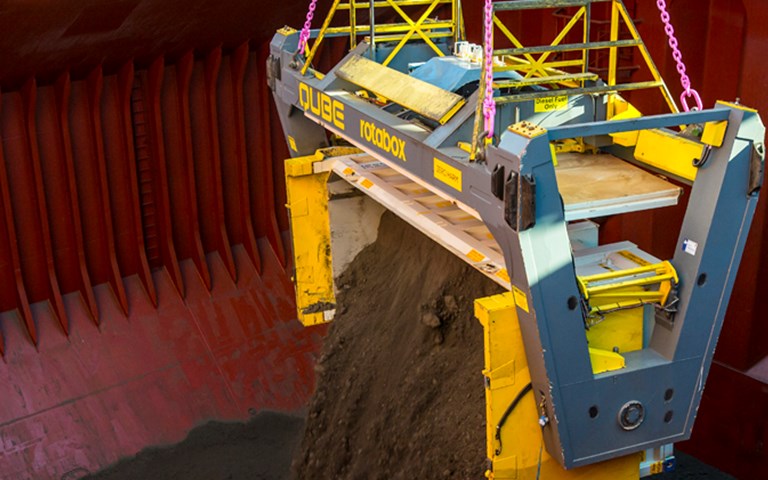Rotabox containers can be used at ports that do not have shiploaders. Courtesy of Qube
Base metal miners in Australia have found that using lidded containers instead of ship loaders decreases dust emissions and adds logistical flexibility at a comparable cost. The Rotabox system, provided by Australian logistics firm Qube, encloses the concentrate on site and only releases it when it is tipped into a ship’s bulk hold.
Qube started the project in 2010 after finding there was no good solution for transporting iron oxide for one of its mining clients. Every available method involved conveyor belts, ship loaders or open stockpiles that produced flyaway dust well in excess of environmental regulations.
The company therefore decided to adapt an existing technology for its own use and dubbed it the Rotabox. According to Antony Perkins, director of project development at Qube, the concept of a rotating frame that could upend a shipping container was first used at a coal mine in South Africa around 1970. However, that design weighed 28 tonnes.
“Our intent was to find a very lightweight frame,” says Perkins. The first Qube design had a six-tonne frame and a 2.4-tonne container, with a payload of 24 tonnes – light enough to be used with a ship’s crane. Maximum payload has since increased to 35 tonnes. Qube also integrated a lid-lifter that opens and closes the container while it is in the hold, trapping any fugitive dust that might otherwise escape when the container is pulled out. The containers have rolled edges and other features to reduce wear and avoid “carryback” when product piles up in the corners and fails to empty out.
At the mine site, the concentrate is loaded into 20-foot-long shipping containers on trucks within an enclosed shed. The height of the containers varies by customer. The containers are weighed and tracked via radio-frequency identification (RFID) tag without re-opening or transferring their contents. When they arrive at port, the containers can be stacked in an open storage area until the ship is ready to load. A crane operator uses either the ship’s crane or a shore crane to lower the container in the rotating frame, lift the container’s lid, upend its contents into the hold, and close the lid. The empty container is hauled back for reuse.
Sandfire
When Sandfire Resources evaluated available logistics services for its DeGrussa copper-gold mine, Rotabox helped Qube stand out. “We were really the second company in Australia to adopt this method for loading ships,” says Graham Edgson, general manager commercial at Sandfire. “What Qube brought to the table is full-service provision.” Along with this relatively new technology, Qube offered a service contract that followed the copper concentrate from site to port to ship.
While nominally more expensive than other options, Rotabox has been keeping Sandfire’s concentrate dust under control for the past three years. It has also provided flexibility, because it does not require a large storage shed and can be used at any available berth, rather than waiting for a ship loader to become free. When Port Hedland temporarily closed down its ship-loading facility to improve its environmental performance, Qube switched to a second port in Geraldton and avoided a five-week delay.
Independence Group
Qube adopted Rotabox out of necessity and continued to use it with new mines in their feasibility stages. After that, “It really took on a life of its own,” says Perkins.
Another miner, Independence Group, converted to Rotabox to deal with problems at the Geraldton Port, where it had been using a different contractor to haul concentrate from its Jaguar copper-zinc-silver mine before loading it out of Qube’s shed. The aging, uncovered conveyors at Geraldton had previously spilled concentrate at transfer points and had been prone to breakdowns. Cleanup cost $2-3 per tonne of concentrate. “All that combined – the cost of loading, the reliability of loading, the environmental concerns – triggered a review of how we load out,” says Brett Hartmann, general manager of operations at Independence Group. Qube began handling Jaguar’s concentrate two years ago, after giving Hartmann a quote that was slightly more expensive than the existing system.
“For myself, it’s very stress free,” says Hartmann. “I can call the guys at Qube and say that we want to load a certain amount of tonnage or certain containers onto a vessel. It’s picked up out of the storage, everything is RFID tagged, so they can pick out the specific containers that we want. They put it on the back of a truck, drive it down to the wharf and load it onto the ship, and I have never had any concerns.”
It reduces stress for Qube as well. “Certainly, the environmental authority here in Australia is very pro-Rotabox,” says Perkins. “When we start any new contract, they come with their dust monitors and all that sort of thing to make sure that they are comfortable with the level of dust that emanates, and we’ve had no problems. There is the option to put misting spray around the rim of the hold, which helps suppress the dust, but to date, we’ve never had to.”
The trade-off is the loading speed; a modern conveyor system can do 1,000 tonnes per hour while Rotabox does 350 or less. Still, now in the fifth iteration of its technology, Qube has made changes for the sake of efficiency: boosting the hydraulics to improve rotating speed, modifying the control systems to make them easier to use and maintain, and specifically adding the ability to plug into Qube’s harbour mobile crane so that the crane driver can use the company’s joystick rather than having a separate remote control, which is required when using a ship’s crane. Onshore cranes tend to be more efficient.
Marketing to Canada
Qube has a total of 14 Australian customers, only some of which are using Rotabox as part of their service contract. Perkins says the company is looking at expanding to other markets: “We’ve been talking to potential customers in Vancouver to use this type of system in those ports.”
The system is best suited to users with shipments of up to 18,000 tonnes at a time. Larger shipments, according to Perkins, would mean an enormous number of containers would need to stay on hand.
Perkins could see splitting off the hardware from the service and licensing it independently: “We have a definite interest in marketing it and selling the technology.”




